|
Issue
#12 - Winter 2007
Health Literacy: Hints for a Healthier You
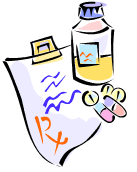 You may not have considered it, but every time you read health information, from food labels to medical forms, you’re exercising your health literacy skills. You may not have considered it, but every time you read health information, from food labels to medical forms, you’re exercising your health literacy skills.
Health literacy is the ability to obtain, process, and understand health information needed to make informed health decisions. Health literacy affects your ability to:
- Use the healthcare system, including filling out complex forms and locating healthcare providers and services
- Share personal information, such as your health history, with providers
- Care for yourself and manage any chronic disease
- Interpret nutrition labels and understand what you’re putting in your body
- Understand how to correctly use over-the-counter and prescription medicines to get the most benefit and avoid risks
- Understand math concepts such as probability and risk
In addition to basic literacy skills, health literacy requires knowledge of health topics and math. For example, you use math skills to calculate cholesterol and blood sugar levels, measure medications, and understand nutrition labels.
If you have limited health literacy, you may lack knowledge or have misinformation about the body as well as the nature and causes of disease. Without this knowledge, you may not understand the relationship between lifestyle factors such as diet and exercise and various health outcomes.
Why is health literacy important?
According to the Institute of Medicine, a nonprofit organization that offers advice on science matters, approximately one-half of the adult population may lack the needed literacy skills to use the U.S. healthcare system. Low literacy has been linked to poor health outcomes such as higher rates of hospitalization, less frequent use of preventive services, and higher healthcare costs.
What do research studies say about the relationship between health literacy and health outcomes?
Use of preventive services
People with limited health literacy skills are more likely to skip important preventive measures such as Pap smears and flu shots. When compared to those with adequate health literacy skills, studies have shown that patients with limited health literacy skills enter the healthcare system when they are sicker.
Knowledge about medical conditions and treatment
People with limited health literacy skills are more likely to have chronic conditions and are less able to manage them effectively. Studies have found that patients with high blood pressure, diabetes, asthma, or HIV/AIDS who have limited health literacy skills have less knowledge of their illness and its management.
Rates of hospitalization
Limited health literacy skills are associated with an increase in preventable hospital visits and admissions. Studies have shown a higher rate of hospitalization and use of emergency services among patients with limited literacy skills.
Health status
Studies show that people with limited health literacy skills are significantly more likely than people with adequate health literacy skills to report their health as poor.
Healthcare costs
Those with limited health literacy skills use more services designed to treat complications of disease and less services designed to prevent complications. Higher rates of hospitalization and use of emergency services among patients with limited health literacy skills is associated with higher healthcare costs.
Stigma and shame
Low health literacy may also have negative psychological effects. One study found that those with limited health literacy skills reported a sense of shame about their skill level. As a result, they may hide reading or vocabulary difficulties to maintain their dignity.
How can I become more health literate?
 STUDY: While you’re in school, many of the classes you’re taking will help raise your health literacy. Reading, English, science, math, and health classes are all important for raising health literacy skills. STUDY: While you’re in school, many of the classes you’re taking will help raise your health literacy. Reading, English, science, math, and health classes are all important for raising health literacy skills.
RESEARCH: If you do have a health problem, be an informed consumer by researching your condition. A good place to start your research is http://www.healthfinder.gov, a federal Website developed for consumers, by the U.S. Department of Health and Human Services and other federal agencies. Of course, the FDA Website (http://www.fda.gov) can also help you find health information about topics such as drugs, medical devices, and food.
ASK: Your healthcare provider can answer questions you have about your health. Advice from your healthcare provider can keep you safe while improving your health literacy. Not sure what to ask? FDA offers a set of questions about medicines to get you started: http://www.fda.gov/cder/consumerinfo/ question_guide.htm. And, the Five Steps to Safer Health Care Fact Sheet offers tips for getting the safest healthcare: http://www.ahrq.gov/consumer/5steps.htm.
What is FDA doing to improve health literacy skills?
FDA participates in a workgroup to improve health literacy skills by raising awareness, building support, and improving practices around health literacy.
Where can I get more information on health literacy?
Back to Table of Contents
Medicines In My Home:
Know Your Medicines for Colds, Fever, and Pain
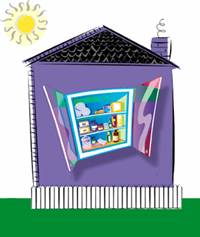 Winter is here and its a season filled with holidays, snow, school vacation (yippee!)… and winter cold and flu season. Many people will have sniffling, sneezing, coughing, or fever during the winter months. Some may use one or more over-the-counter medicines to treat those problems. How much do you know about medicines for cold, fever, and pain? Winter is here and its a season filled with holidays, snow, school vacation (yippee!)… and winter cold and flu season. Many people will have sniffling, sneezing, coughing, or fever during the winter months. Some may use one or more over-the-counter medicines to treat those problems. How much do you know about medicines for cold, fever, and pain?
What's In a Name? ... Not a lot.
The name of a medicine may not tell you what the medicine treats or if it’s right for you and your problem. Companies that make medicines often sell a whole group of them under the same brand name. The same brand name may be used for a medicine for fever, for pain, for a cold, for a cold and cough, and for allergies. And, if you aren’t careful, you may use the wrong one.
How do you choose the correct medicine for your problem?
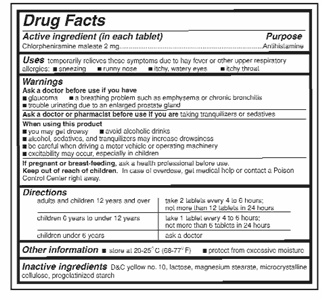 Read the Drug Facts label on the medicine package. The Drug Facts label can help you pick a medicine that’s right for you and your problem. Read the Drug Facts label on the medicine package. The Drug Facts label can help you pick a medicine that’s right for you and your problem.
The Drug Facts label tells you:
- The active ingredients (the parts that make it work)
- What the medicine does (purpose)
- Problems the medicine treats (uses)
- Warnings - who should not use the medicine, who should ask a doctor or pharmacist before using the medicine, reasons to stop using the medicine, and ways to avoid harm
- How to use the medicine safely (directions)
What if you need to treat more than one problem?
Choose a medicine that treats only the problems you have. Some over-the-counter (OTC) medicines are made to treat more than one problem and have more than one active ingredient. Examples of these medicines are:
- Cold and flu medicines
- Some allergy medicines
- Cough and cold medicines
Since all medicines can cause unwanted side effects, it’s important to choose a medicine that treats only the problems you have. Don’t choose a medicine that includes extra active ingredients for problems you don't have. For example, some over-the-counter medicines treat stuffy nose, sneezing, or cough and also include an ingredient to treat pain and fever. If you don’t have pain or fever, you shouldn’t pick a medicine that treats these problems.
Medicines for Fever and Pain: What You Should Know
There are two kinds of over-the-counter medicines that treat pain and fever: acetaminophen and nonsteroidal anti-inflammatory drugs (NSAIDs). The NSAIDs include ibuprofen, naproxen, ketoprofen, and aspirin. Children and teenagers should not use aspirin for fever or flu, because it may cause Reye's syndrome, a severe illness that can affect the blood, liver, and brain. Medicine labels may list aspirin-like medicines by other names including: acetylsalicylic acid, acetyl salicylate, salicylic acid, or salicylate. Products that have aspirin or aspirin-like medicines have a warning on the box about Reye’s syndrome.
Pain or fever medicines like acetaminophen or ibuprofen are often added to other active ingredients that treat cough, sinus congestion (stuffy nose), or allergies.
These medicines, if used only when needed and as directed on the label, are safe and effective. But using too much of them, using them too often, or for too long can be dangerous. For example:
- Taking more acetaminophen than directed on the label can cause serious liver damage. You may not know you’ve damaged your liver right away, because signs of liver damage often don’t appear for many days.
- Taking more NSAID than directed can damage your kidneys and can cause stomach bleeding.
There are many OTC medicines that contain the same active ingredient. This is not always easy to see or understand from the name on the package. If you use a pain medicine for your headache and a cough-cold-fever medicine for your cold symptoms, you may be taking twice the recommended dose of acetaminophen or NSAID and not know it. This can happen with two over-the-counter medicines or with an over-the-counter medicine and a prescription pain medicine. Acetaminophen and NSAIDs can be in prescription pain medicines and in prescription and over-the-counter medicines for colds and allergies. How can you make sure that you don’t accidentally take too much of a medicine?
- Read the label
- Check the active ingredients in your medicines
- Don’t use two medicines together if they have the same active ingredient.
- If you aren’t sure which medicine to use or don’t know the active ingredients in a prescription medicine, ask your pharmacist or healthcare professional.
Cut out and post these tips near your medicines to remind you to read the label each time.
 Read the label each time before you use a medicine. Be sure it's right in 5 ways: Read the label each time before you use a medicine. Be sure it's right in 5 ways:
- the right medicine
- for the right person
- in the right amount
- at the right time
- in the right way (swallow, chew, apply to skin)
|
Back to Table of Contents
Reducing Your Risk of Foodborne Illness from Fresh Produce
As it investigates an outbreak of illnesses that may be related to Salmonella typhimurium bacteria in produce, the FDA is reminding consumers of steps they can take to keep their food safe.
Did You Know?
During an outbreak FDA works closely with states and CDC to identify the most likely food item(s) that caused the outbreak. If and when a food item is identified, FDA will investigate where the product came from and what may have gone wrong during its production, packing or distribution that could have led to contamination. |
Salmonella can cause serious and sometimes fatal infections in young children, frail or elderly people, and others with weakened immune systems. Healthy people often experience fever, diarrhea (which may be bloody), nausea, vomiting, and abdominal pain. In rare circumstances, infection can result in the organism getting into the bloodstream and producing more severe illnesses.
Foodborne Investigations
Investigations of foodborne illness usually begin at the local health department level. A variety of scientific and technological methods to trace the source of reported illnesses are used. Modern technologies, such as PulseNet (the network of public health laboratories that performs “DNA fingerprinting”), have greatly improved the speed and precision of these types of investigations.
In light of recent outbreaks, FDA is emphasizing consumer advice to reduce the risk of foodborne illness, including Salmonella-related illness, from fresh produce:
Buying Tips for Fresh Produce
- Purchase produce that is not bruised or damaged.
- When selecting fresh cut produce - such as a half a watermelon or bagged mixed salad greens - choose only those items that are refrigerated or surrounded by ice.
- Bag fresh fruits and vegetables separately from meat, poultry and seafood products when packing them to take home from the market.
Storage Tips for Fresh Produce
- Certain perishable fresh fruits and vegetables (like strawberries, lettuce, herbs, and mushrooms) can be best maintained by storing in a clean refrigerator at a temperature of 40° F or below. If you're not sure whether an item should be refrigerated to maintain quality, ask your grocer.
- All produce that is purchased pre-cut or peeled should be refrigerated within two hours to maintain both quality and safety.
- Keep your refrigerator set at 40° F or below. Use a refrigerator thermometer to check!
Preparation Tips for Fresh Produce
- Many precut, bagged produce items like lettuce are pre-washed. If so, it will be stated on the packaging. This pre-washed, bagged produce can be used without further washing.
- As an extra measure of caution, you can wash the produce again just before you use it. Precut or prewashed produce in open bags should be washed before using.
- Begin with clean hands. Wash your hands for 20 seconds with warm water and soap before and after preparing fresh produce.
- Cut away any damaged or bruised areas on fresh fruits and vegetables before preparing and/or eating. Produce that looks rotten should be discarded.
-
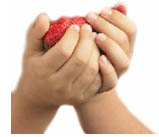 All unpackaged fruits and vegetables, as well as those packaged and not marked pre-washed, should be thoroughly washed before eating. This includes produce grown conventionally or organically at home, or produce that is purchased from a grocery store or farmer's market. Wash fruits and vegetables under running water just before eating, cutting or cooking. All unpackaged fruits and vegetables, as well as those packaged and not marked pre-washed, should be thoroughly washed before eating. This includes produce grown conventionally or organically at home, or produce that is purchased from a grocery store or farmer's market. Wash fruits and vegetables under running water just before eating, cutting or cooking.
- Even if you plan to peel the produce before eating, it’s still important to wash it first.
- Washing fruits and vegetables with soap or detergent or using commercial produce washes is not recommended.
- Scrub firm produce, such as melons and cucumbers, with a clean produce brush.
- Drying produce with a clean cloth towel or paper towel may further reduce bacteria that may be present.
Separate for Safety
 Keep fruits and vegetables that will be eaten raw separate from other foods such as raw meat, poultry or seafood - and from kitchen utensils used for those products. Keep fruits and vegetables that will be eaten raw separate from other foods such as raw meat, poultry or seafood - and from kitchen utensils used for those products.
In addition, be sure to:
- Wash cutting boards, dishes, utensils and counter tops with hot water and soap between the preparation of raw meat, poultry and seafood products and the preparation of produce that will not be cooked.
- For added protection, kitchen sanitizers can be used on cutting boards and counter tops periodically. Try a solution of one teaspoon of chlorine bleach to one quart of water.
- If you use plastic or other non-porous cutting boards, run them through the dishwasher after use.
For more information
To learn more about keeping food safe from bacteria visit the Partnership for Food Safety Education’s (PFSE) Fight Bac website at http://www.fightbac.org/
PFSE is a not-for-profit organization that unites industry associations, professional societies in food science, nutrition and health, consumer groups, and the U.S. government to educate the public about safe food handling.
Source: http://www.fda.gov/bbs/topics/NEWS/2006/NEW01503.html
Back to Table of Contents
Learn About It Online: Safe Handling of Raw Produce and Fresh Squeezed Juices
The FDA's Center for Food Safety and Applied Nutrition Safe Handling of Raw Produce and Fresh-Squeezed Fruits and Vegetable Juices website provides information on staying healthy and safe when buying, storing, and preparing fresh produce.
 Fruits and vegetables are a key component of a healthy diet, and it's important to handle these products safely in order to reduce the risk of foodborne illness. Fruits and vegetables are a key component of a healthy diet, and it's important to handle these products safely in order to reduce the risk of foodborne illness.
The website includes information about
- Avoiding Foodborne Illness
- Buying Tips for Fresh Produce
- Storage Tips for Fresh Produce
- Preparation Tips for Fresh Produce
- Safety for Fresh-Squeezed Juices
Back to Table of Contents
Egg Safety
With the start of 2007, it's a good time to refresh your egg handling and preparation know-how to avoid foodborne illness. Salmonella Enteriditis (SE), bacteria sometimes found in eggs cause an estimated 118,000 illnesses each year, and young children and people with weakened immune systems are the most vulnerable.
Many favorites, such as cookie dough, homemade eggnog, and some types of stuffing, may contain eggs that are raw or undercooked. A 2006 FDA survey of consumer food safety practices found that cookie dough is one of the major sources of raw egg in the American diet, and that only three percent of respondents always use a food thermometer when cooking baked egg dishes such as stuffing.
To avoid egg-related illness from holiday foods:
- Do not eat unbaked cookie dough.
- Cook baked egg-containing dishes to 160° F.
- Make recipes that call for raw or undercooked eggs, like eggnog, with eggs that have been treated to destroy Salmonella or with pasteurized egg products.
FDA requires the following statement on packages of fresh eggs that have not been treated to destroy Salmonella:
Safe Handling Instructions: To prevent illness from bacteria, keep eggs refrigerated, cook eggs until yolks are firm, and cook foods containing eggs thoroughly.
Find more information about holiday food safety at http://www.cfsan.fda.gov or call 1-888-SAFEFOOD.
Source: http://www.fda.gov/bbs/topics/NEWS/2006/NEW01535.html
Back to Table of Contents
Online Tools Help Consumers Learn About Nutrition Facts Labels
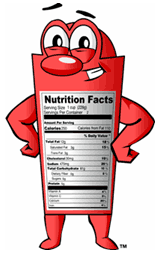 Having trouble using the Nutrition Facts label? Not sure how to choose food that meets your daily dietary needs? The Department of Health and Human Services and FDA have launched two web-based tools to help you use the Nutrition Facts label to choose nutritious foods and manage a healthy weight. Having trouble using the Nutrition Facts label? Not sure how to choose food that meets your daily dietary needs? The Department of Health and Human Services and FDA have launched two web-based tools to help you use the Nutrition Facts label to choose nutritious foods and manage a healthy weight.
Make Your Calories Count (http://www.cfsan.fda.gov/labelman) is an interactive online learning program that provides consumers with information to help plan a healthful diet while managing calorie intake. The program guide features an animated character called “Labelman” who expertly leads viewers through a series of lessons on the food label. You’ll find exercises that explore the relationship between serving sizes and calories, while learning how to limit certain nutrients (saturated fat and sodium) and get enough of others (fiber and calcium).
Eating Healthier and Feeling Better Using the Nutrition Facts Label (http://www.cfsan.fda.gov/~acrobat/nutfacts.pdf) is a brochure that explains how to use the Nutrition Facts label while you shop and plan meals. It includes information that will help you understand the relationship between calories and serving size, which can help you use the label to manage your calorie intake. The brochure is targeted for use by consumers but health professionals can also use the brochure to teach people how to make healthier food choices.
These new learning tools are part of a commitment by HHS and FDA to help reduce the number of overweight persons and obesity in America. The Web-based program is part of FDA’s response to the recommendations of its Obesity Working Group, and is based on recommendations in the 2005 Dietary Guidelines for Americans. The Dietary Guidelines are the foundation of the federal government's science-based advice designed to help Americans choose diets that meet nutrient requirements without exceeding calorie needs, promote health, support active lives, and reduce the risk of chronic disease.
Source : http://www.fda.gov/bbs/topics/NEWS/2006/NEW01508.html
Back to Table of Contents
FDA BROADENS ACCESS TO
LEAD TESTING
 FDA has expanded the availability of the first simple and portable lead test system to more than 115,000 certified point-of-care locations nationwide, including healthcare clinics, mobile health units and schools. This will allow children and adults to be easily tested and treated quickly for lead poisoning. Lead poisoning can cause learning disabilities or even death. FDA has expanded the availability of the first simple and portable lead test system to more than 115,000 certified point-of-care locations nationwide, including healthcare clinics, mobile health units and schools. This will allow children and adults to be easily tested and treated quickly for lead poisoning. Lead poisoning can cause learning disabilities or even death.
The test, called the LeadCare II Blood Lead Test System and made by ESA Biosciences of Chelmsford, Massachusetts, is used to screen children and adults for harmful levels of lead using a blood sample. It’s performed while the patient is present, in as little as three minutes. The rapid result means a second sample for confirmatory testing can be obtained quickly, reducing the need for a follow-up visit.
FDA broadened access to the test system by granting a Clinical Laboratory Improvement Amendment (CLIA) waiver, because the test is simple, accurate and reasonably free of harm. This waiver permits widespread distribution to nontraditional laboratory sites that have CLIA certification.
The ease and accuracy of the test system was evaluated by testing 516 blood samples over a two-month period at 11 sites. The test instrument applies an electrical current to the patient's blood sample, causing lead to collect on disposable sensors. Studies show nearly 98 percent of the values measured by the test instrument were within Occupational Safety and Health Administration's recommendations for blood lead proficiency testing. Blood lead values above 10 milligrams per deciliter need to be confirmed with another laboratory method.
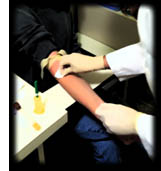 For more information on lead testing For more information on lead testing
For more information on lead poisoning
For more information on how the FDA cleared the LeadCare II Blood Lead Test System, go to http://www.accessdata.fda.gov/scripts/cdrh/ cfdocs/cfPMN/pmn.cfm?ID=19475
Source: http://www.fda.gov/cdrh/oivd/news.html#091806
Back to Table of Contents
Calendar
of National Health Events
Other health events that may be of interest to teens are listed on our website at
http://www.fda.gov/cdrh/fdaandyou/calendar.html
Back to Table of Contents
| About FDA & You
FDA & You is an FDA publication to inform
and encourage health educators and students to learn
about the latest FDA medical device and health news.
The publication's contents may be freely reproduced.
Comments should be sent to the Editor.
Editor: Alicia Witters
Editor: Edie Seligson
Researcher: Carol Clayton
Lesson Plans: Tamara Wirt
Email: FDAandyou@cdrh.fda.gov
Read us online at:
http://www.fda.gov/cdrh/fdaandyou
Department of Health and Human Services,
Food and Drug Administration
Center for Devices and Radiological Health
Rockville, MD 20850
Special thanks to: CDER, CDRH, and CFSAN for contributing to this issue. |
|








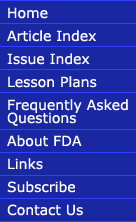

![]()